After the last write up on this topic – My Favourite Place To Dive? – Part 4 Galapagos – I took a big breather, because I suspected that this final instalment in the series regarding my favourite places to dive was going to be a bit of a whopper. I also needed to finish up the most recent gallery for the location.
This series of posts was inspired by an oft posed question – What is your favourite place to dive? I have always answered that there are several places, for several reasons, that I love to dive. In this blog series I set about trying to describe them with words and with pictures. The list has been shared chronologically, and started with British Columbia, then Cocos Island (Costa Rica), Fiji, Galapagos, and finally, this instalment – Indonesia.
As I mentioned at the outset of this saga, there are still several more diving meccas that I have yet to visit – Palau, the Philippine Islands, the Red Sea, and the Maldives, to name the current leaders on the wishlist.
So now I have tipped my hand and revealed Indonesia as my final choice of favourites. I really like the diving in Thailand (it has some similarities in creature features as Indonesia, but lacks the epic biodiversity), and it is easier to get to than Indonesia, but it doesn’t quite make my favourites list – mostly because of significant areas of coral bleached and tsunami damaged reefs, and also because of the amount of diver pressure on a relatively limited number of good dive sites. I do have to make special mention of Richelieu Rock, which ranks up there as one of my all-time favourite dive sites (hey – that could be another blog series ;^), and also give a big nod to the land-based diving around the Phi Phi islands – which is lovely, but also feeling some pressure from too many divers, staying on a sadly over-developed island. I have put together comprehensive trip reports for my two journeys to Thailand, which were both combination live aboard and land-based diving trips – you can find them here (2008) and here (2011).
In contrast to the limited good diving of Thailand, Indonesia is a vast archipelago (at last count, something in the range of 17,500 islands), and there are seemingly unlimited dive site possibilities with that much shoreline. Adding to the sheer magnitude of coastline is the Wallace Line (which cuts right through the sprawling island nation) – described as the imaginary boundary at which the Australian currents meet the Asian currents. What results is a staggering biodiversity – many of the Asian creatures, many of the Australian creatures, and the hybrids spawned when the two met and mated.
There are several regions of Indonesia that offer great diving – so far, I have been to Bali (Tulamben area – several visits), Ambon & The Banda Sea (twice), Komodo, Raja Ampat and Lembeh. Every year it seems that new areas are being opened to divers. The newest hot spot is Alor (and East Timor, which shares the island with Indonesia but is a separate country) – which I would love to get to, but don’t see an opportunity any time soon. I do look forward to a couple of trips back to Komodo in the next year (on two different live aboards), as well as a land-based stay at Wakatobi, located off the southeast coast of the big island of Sulawesi.
To put it all in perspective, I have dug up a map of Indo and highlighted the areas in red where I have been diving thus far. As you can see, there are numerous regions I have not yet explored.
So, how to begin to describe the diving? Probably easiest for me to break it down by location. I will give as brief a description as I can muster, with some images as examples of creature features, and then link to extensive trip reports written about each of these places for those who would like to read more at depth.
Bali
In my experience, Bali is the easiest of the Indonesian diving destinations to get to, and is a gateway to all other areas where I have been diving. Denpasar airport, located on the southern tip of the island, is an international airport, and from the west coast of North America there are several options to get there, usually transiting through Singapore, or Hong Kong, or…
The southern parts of the island of Bali are known for cooler, more turbid waters, and a population of mola mola (aka sunfish). Despite several visits to Bali, I still haven’t got myself on a charter that takes in this diving – Nusa Penida/Lembongan/Crystal Bay are the target spots.
When I travel to destinations where I will be going out on a live aboard, it has become my custom to always add a few days on the front end, before boarding the boat. This hugely decreases the stress of delayed flights and/or baggage (been there, done that, on both counts). It also gives me a chance to get in the time zone, rest up after the long haul from Vancouver, and enjoy some diving in the process.
Tulamben is located up on the northeast coast of the island of Bali – about a three hour drive from the airport. Tulamben is most notorious as the location of the Liberty wreck – a WWII supply ship that was torpedoed by the Japanese which limped in to be beached, where it sat and rusted until a volcano eruption in 1963 rolled it back into the sea. It sits in shallow waters, and is a fantastic dive. In recent years, it has been discovered that there is some great (clean!) muck diving in the area as well. Right out in front of Scuba Seraya Dive Resort (shore diving!) is some of the best mucking I’ve done. A bit eclipsed by the Liberty wreck and the great muck diving are some very nice reef/wall dives. Tulamben has it all – an oasis from the maddening crowds of southern Bali tourist traps, and great diving from land-based operations.
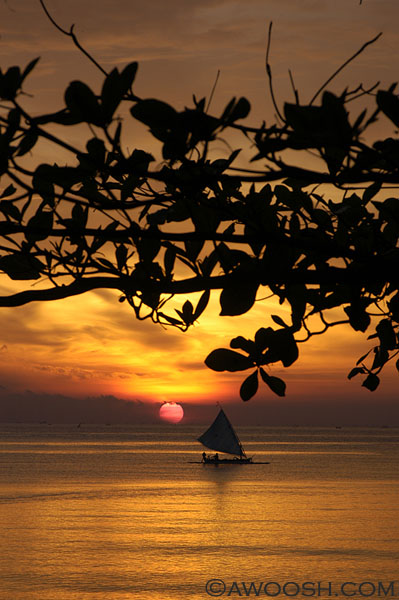
Bali Sunrise
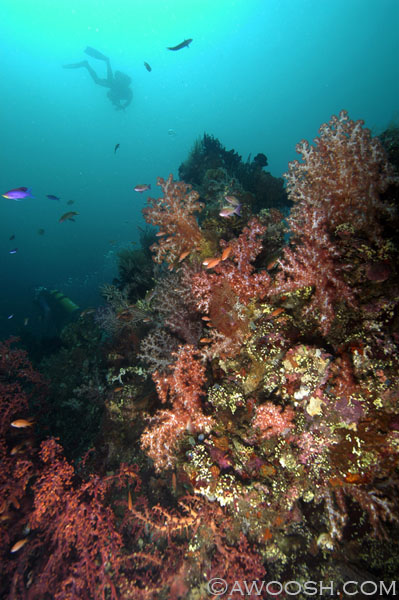
Soft Coral Growth on the Liberty Wreck
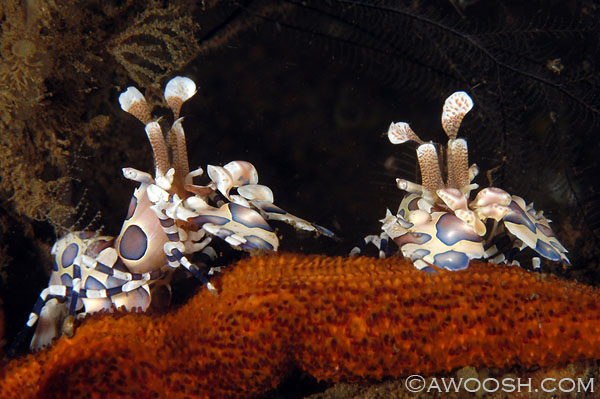
A Pair of Harlequin Shrimp, on a Sea Star

Juvenile Emporer Angelfish
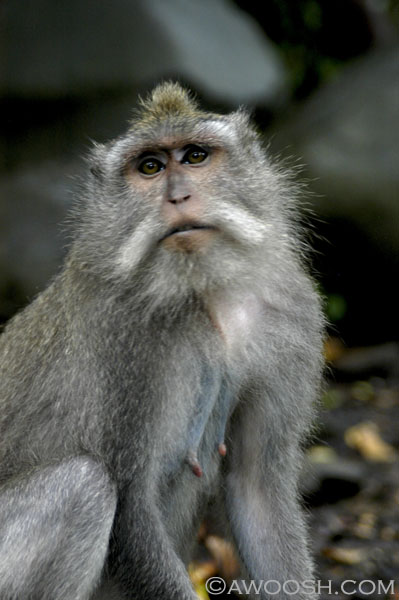
Monkey Forest Inhabitant
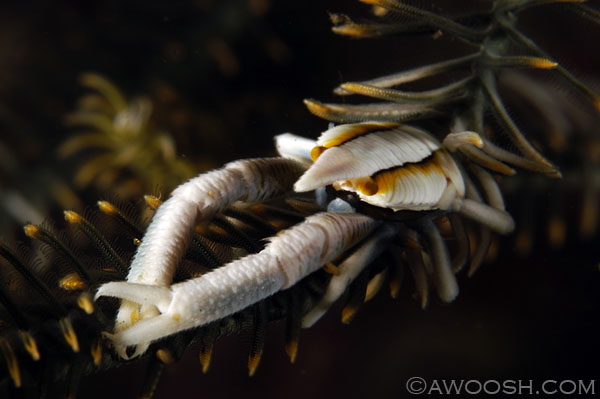
Crinoid Squat Lobster
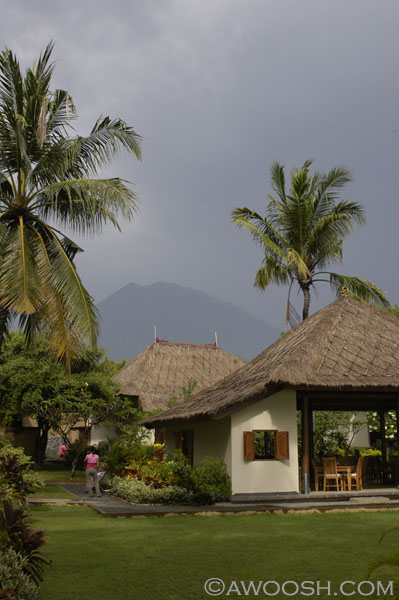
Scuba Seraya Resort
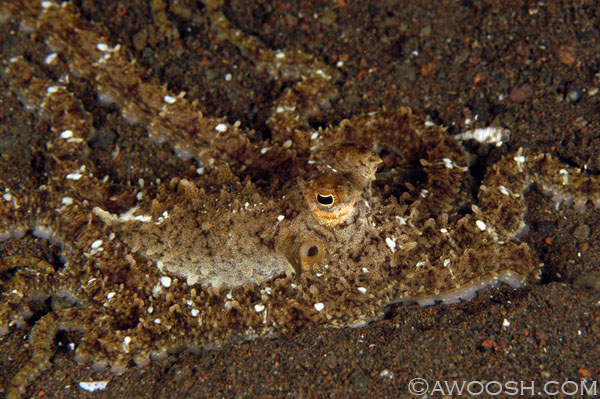
Mimic Octopus
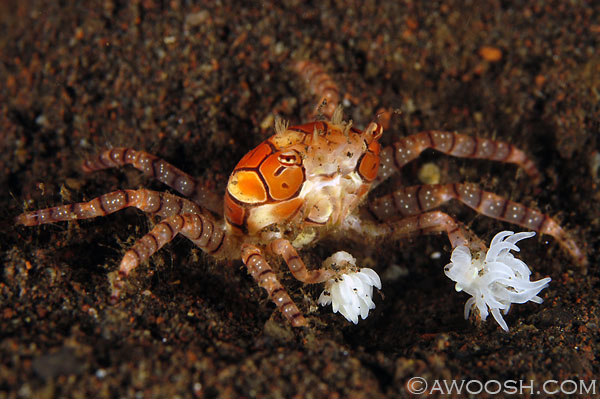
Mosaic Boxer Crab
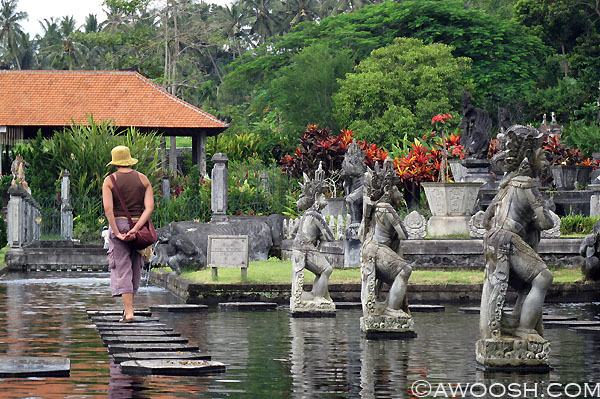
Beautiful Bali
Bali Links: Awoosh Bali Pictorial Trip Report | March 2008 Photo Gallery | December 2008 Photo Gallery
___________________________________________
Ambon Harbour
I’ve been to this region of Indonesia twice. Those two trips started in Bali for a few days of diving at Tulamben, then we flew on to Ambon Island (home of arguably the world’s best known muck diving – and also the world’s dirtiest ;^). Ambon was where we boarded the live aboards that took us out on ten day itineraries through small island groups south of Ambon – to what used to be called the Spice Islands.
What can I say about Ambon Harbour? Unless you are a photographer or a keen critter hound, this might not be the diving for you. The best of the sites are littered with garbage, and the water is dirty too (although there are some much cleaner muck sites away from settlements). Ambon Harbour is a fishing and cargo port, and there appears to be a distinct lack of concern for the ocean environment. Garbage is literally dumped in the sea in Ambon Harbour, and a blizzard of plastic bags blows through regularly. The bottom of legendary sites like Laha 1 & 2 are the dirtiest – clothing, shoes, diapers, plumbing fixtures, broken bicycles, dead rats – the list is endless of the stuff I’ve seen there.
But amongst all that detritus are some incredible finds – flambouyant cuttlefish, snake eels, Coleman shrimp, squat lobsters, several varieties of jawfish, tons of crinoid cuttlefish, wonderpus, mimic octopus, ribbon eels, a wide variety of nudibranchs, giant frogfish, seahorses, weedy scorpionfish, schooling pinnate batfish, mandarinfish (out in daylight!), Ambon scorpionfish, leaf scorpionfish (in several colours), many varieties of anemonefish, massive populations of moray eels (I saw over 30 on one dive at Laha, and gave up counting), and pipefish (including ghost pipefish) are regularly spotted. Last week, someone reported seeing a hammerhead shark at Laha – it is pretty clear you never know what is going to show up at that crazy wonderful place.

Paddle Fin Rhinopias
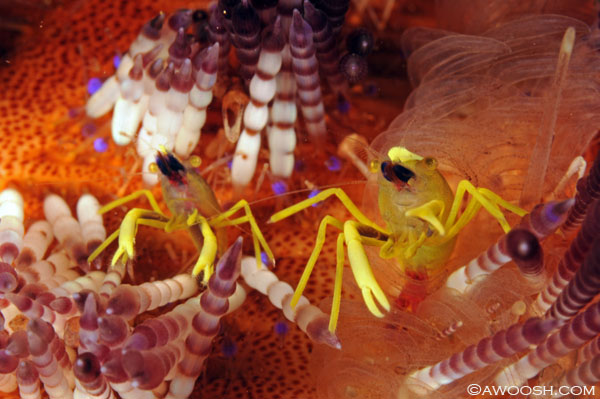
A Pair of Squat Lobsters on a Fire Urchin
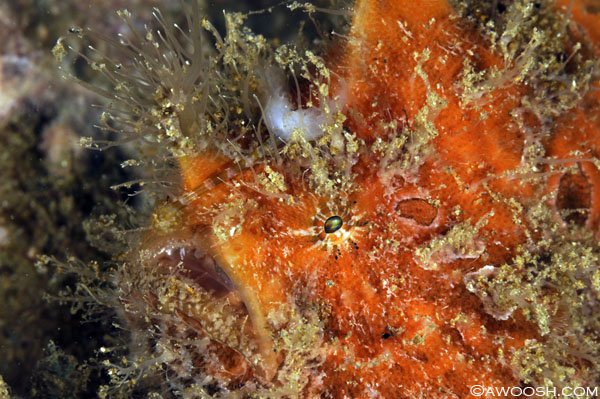
Hairy Frogfish

Leaf Scorpionfish (Pink Variation)
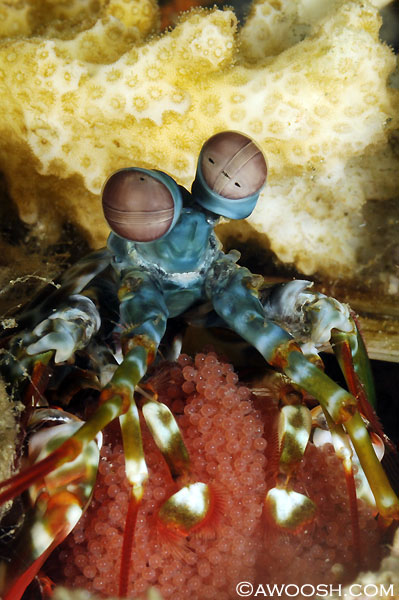
Peacock Mantis Shrimp with Eggs
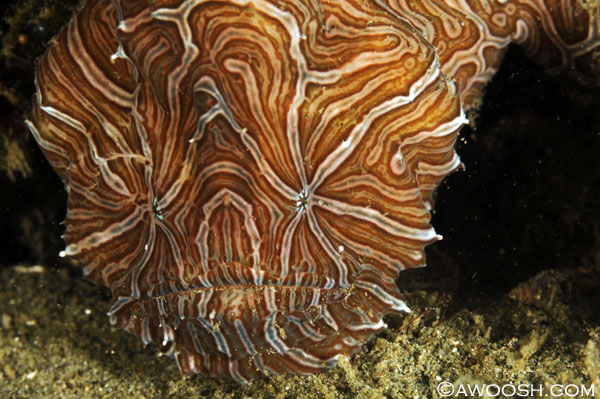
Ambon Psychedelic Frogfish
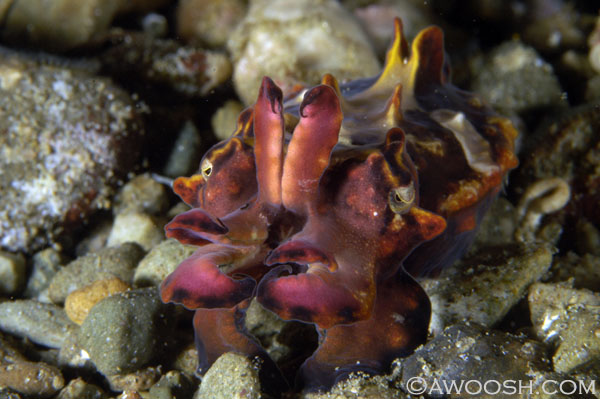
Flamboyant Cuttlefish
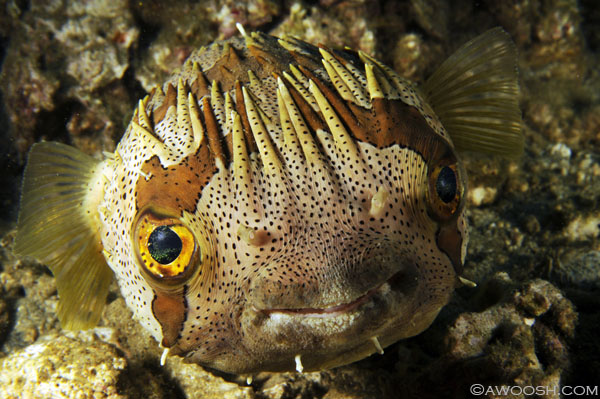
Porcupine Fish
Ambon Links: Awoosh Ambon Pictorial Trip Report | 2008 Photo Gallery | 2010 Photo Gallery | 2011 Photo Gallery
___________________________________________
Banda Sea
The Banda Sea has some great diving – some beautiful reef structure – especially off the coast of Ambon Island, and around Banda Basur – the center stage of the historic ‘Spice Islands’, which are located a couple of days motoring to the south. The history of the area is interesting, and the land tour at Banda Basur of the old Dutch fortress (lots of dungeons for torturing the locals who opposed the occupation of their islands, and other would-be colonialists who wanted in on the lucrative spice business), and of the spice plantations, was educational.
Interestingly, on our two trips in the Banda Sea (two different operators – the now defunct Archipelago Adventurer II, and the Arenui), we only dove a couple of the same sites. This leads me to believe that there is plenty of great diving in the region, with minimal diver pressure, mostly due to the remoteness of the location. It is possible to do some land-based diving out of Banda Basur, and also out of Ambon, but doing it this way would severely limit the dive site choices.
The one notable thing missing from the Banda Sea are large animals and schooling fish (with a couple of exceptions – most notably in a small area where local islanders have decided to create a no-take zone). So, I suspect this is due to over-fishing. Sharks were notably absent on both our trips. We also did not see mantas, or dugongs (which are known to populate one of the islands we dove). But there was more than enough stuff in the water to keep me happy for the duration of two trips there. In fact, I’d go back again in a heartbeat…
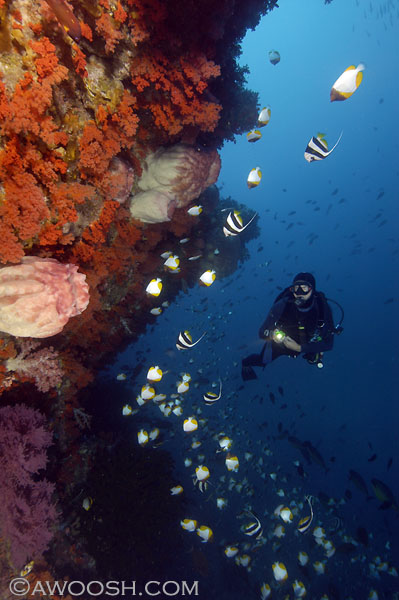
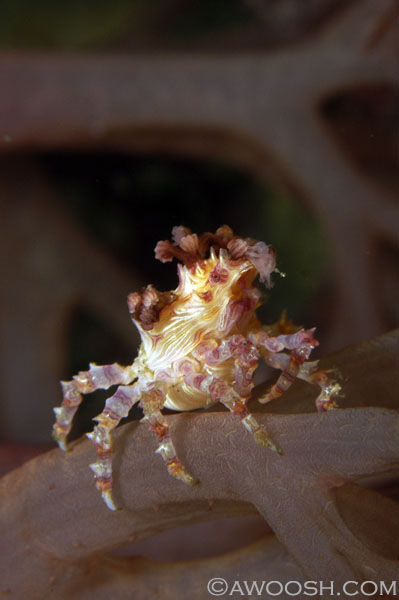
Soft Coral Crab
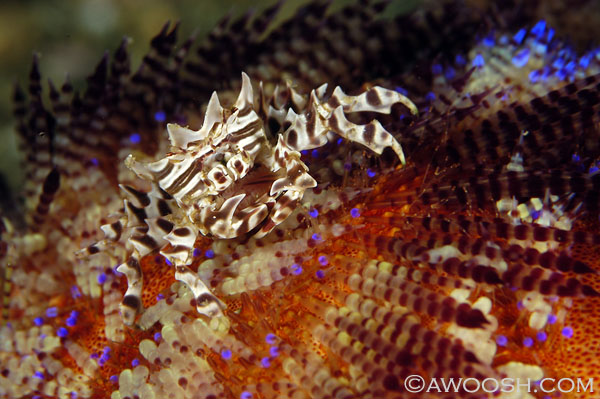
Zebra Crab on Fire Urchin
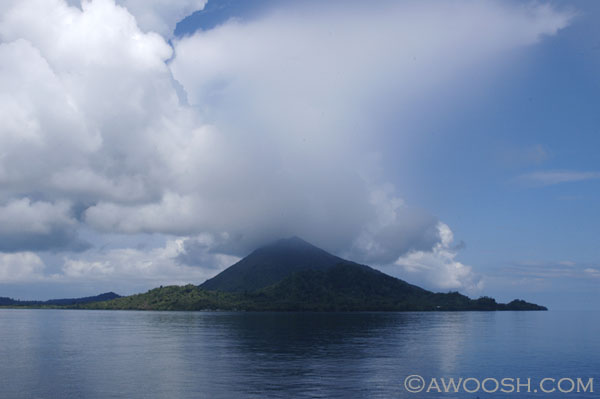
Banda Basur
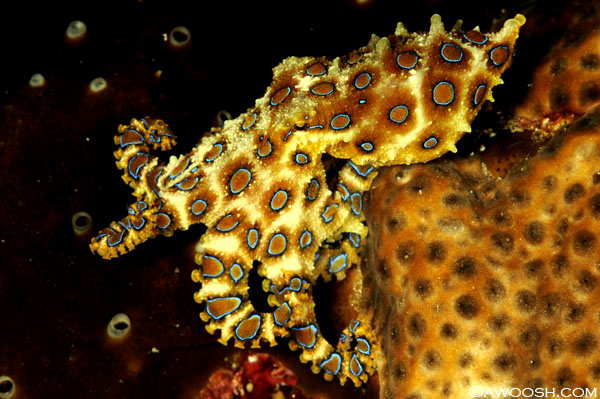
Blue Ringed Octopus
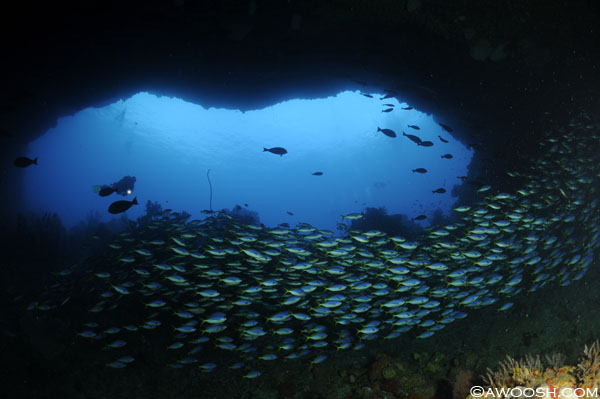
The Arch at Ambon Island
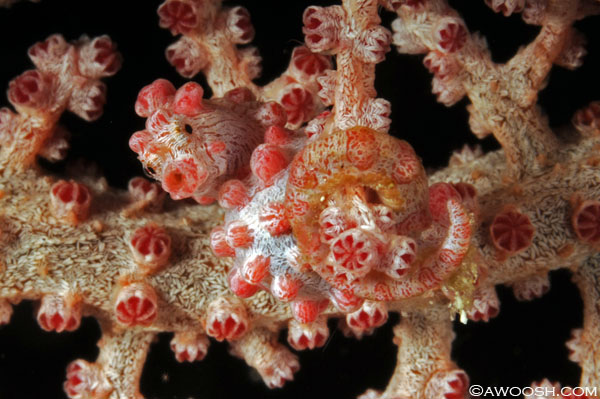
Pygmy Seahorse
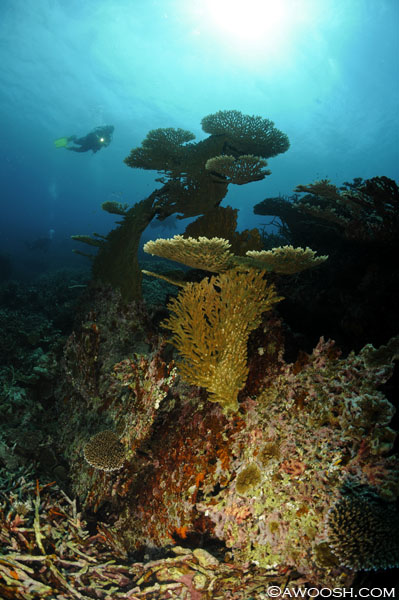
Sea Fan Condos at the Lava Flow, Banda Basur
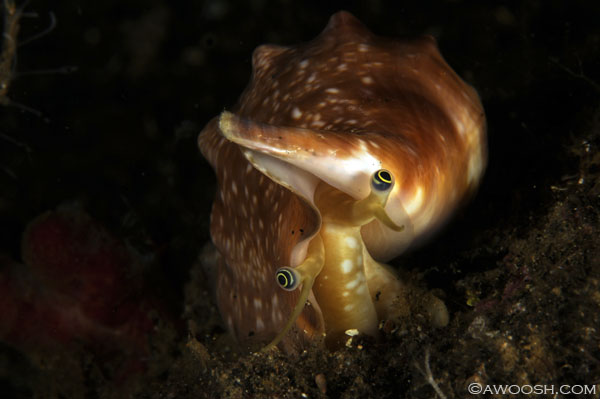
Vomer Conch

Over/Under at the Lava Flow, Banda Basur
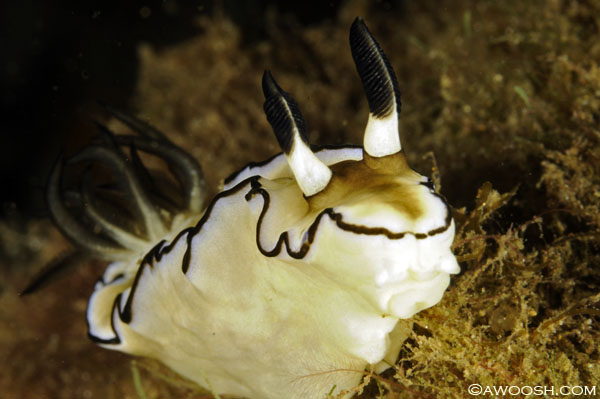
Glossodoris Atromarginata Nudibranch
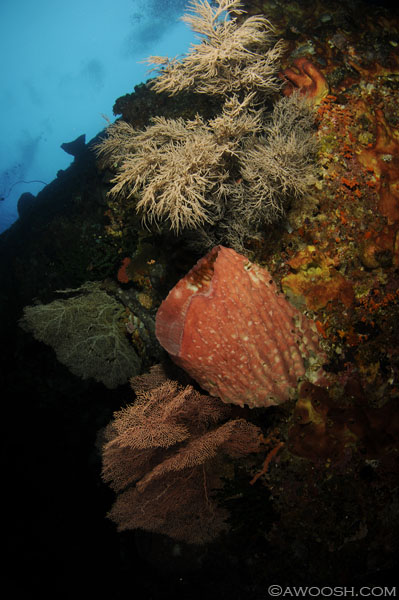
Wide Angle View
Banda Sea Links: 2008 Photo Gallery | 2011 Photo Gallery | Mike Southard’s Most Excellent Group Trip Report – Videos and Images by Many Contributors
___________________________________________
Komodo
I never got around to putting together a trip report for this adventure, so I will spend a little more time on this section to describe the trip.
Our trip to Komodo also started in Bali, with yet another great stay at Scuba Seraya. On this trip we were traveling with our three daughters – all divers – and we had chartered a modest boat from an Indonesian company called Grand Komodo. The boat was the Nusa Tara – the smallest in their fleet (6 passengers max), but it worked well for us, and we loved having the thing to ourselves.
Getting to Komodo was a total trip – about a one hour flight out of Denpasar, Bali to Bima, on the island of Sumbawa. Sumbawa is not on the mainstream Indonesia tourist radar – steep mountains, humble fishing villages, ubiquitous rice paddies and banana plantations – it’s probably a bit what Bali was like before it was inundated with tacky tourists. It is also minus the Hindu population of Bali, and plus an apparently devout Muslim population.
There is minimal tourist infrastructure on Sumbawa, so other than a few truly intrepid travelers (and some crazy surfer dudes) the locals aren’t much used to seeing white-faced visitors, and the welcome we felt was not so much. That feeling was amplified when our bus rounded a corner in the main town of Bima, after a long and winding road back from the port of Sape. We were near the end of that big drive back to the airport after being offloaded from the boat in Sape, only to drive in to the middle of a huge anti-American protest (something to do with an altercation between Israel and the Palestine). Seeing jacked-up, masked protestors waving guns, and signs with George W’s face with a big red X over it, and smouldering US flags, was enough to give us pause. While we were trying to figure out whether we should duck and hide, or somehow signal that we were actually non-partisan Canadians (like they would care ;^), our Indonesian bus driver had the wherewithall to just keep on driving. The crowd parted reluctantly for the bus, and we were through. Scary though…
Despite the less than ideal transit (note to self – accessing the great diving of Komodo is also possible with some live aboard operators through the more touristed island of Flores), Komodo itself is fantastic. Beautiful, unspoiled islands (which are normally very arid, but as we were there in the rainy season, they were all gloriously greened up). Few boats. Wonderful, although at times challenging, diving (due to currents). Creatures big and small. Beautiful, pristine stands of hard corals. Tons of biodiversity – healthy schools of fish, manta rays in squadrons (!!!), sharks, lots of little critters that made for a tough call on every dive – whether to go wide, or go macro?
Some of the best diving we did was down around Rinca Island, in the southern part of the region. We had a rough crossing from Sape (the fishing village on Sumbawa where we boarded the boat) over to Komodo, and then it really blew up for a few days. The captain decided the best place for safe harbour was in a beautiful calm bay near Rinca. This is where the epic Cannibal Rock dive site is located, and as such, we got to dive it several times. Magic…
Rinca was also where we spotted our first Komodo Dragon. They are fearsome creatures (known to hunt and eat humans) – patrolling the beach like something out of some bad Japanese monster movie. We got another chance to see one (up close and personal this time) on a land tour on Komodo Island. Luckily, that one was bloated and flaked out on the beach after eating the leftover lamb carcass from the big New Year’s beach barbecue the night before.
I mentioned currents earlier in this bit about Komodo – the region of Indo is known for them, as the wide strait between the island of Komodo and the island of Flores is not very deep, and a huge whack of water goes through it on every tidal exchange. We only did one hairy current dive, at a site aptly named Current City. Luckily our daughters sat that one out – it is a fairly small site, and there was a wicked downcurrent on the lee side of the reef that took us for a bit of an elevator ride. With some trip planning around moon phases, and conscientious crew with local knowledge picking appropriate sites for the water conditions, currents should not be a big issue for anyone wanting to take in this glorious diving.
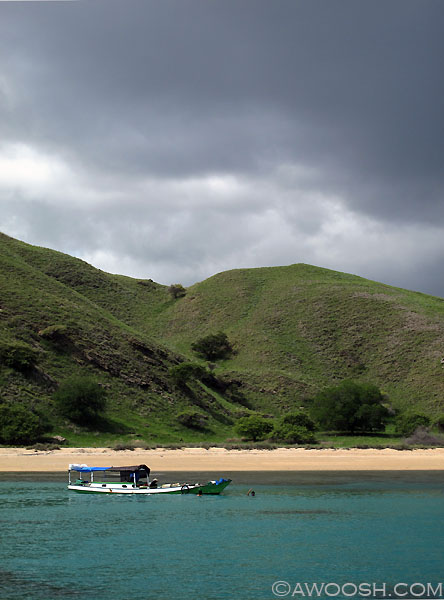
Komodo Scenery
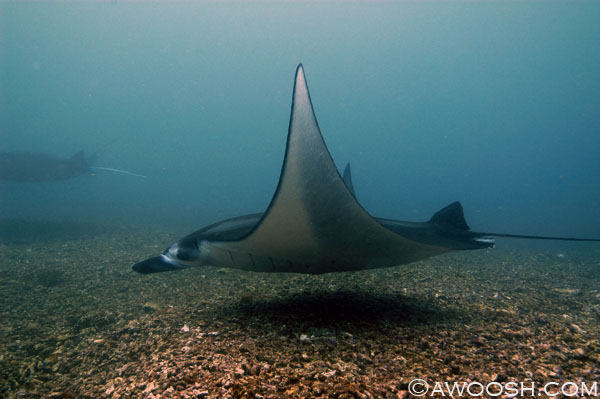
Manta, Manta

Cannibal Rock

Komodo Dragon Patrolling the Beach at Rinca Island

Chromodoris Elizabetha Nudibranch

There be current ;^)
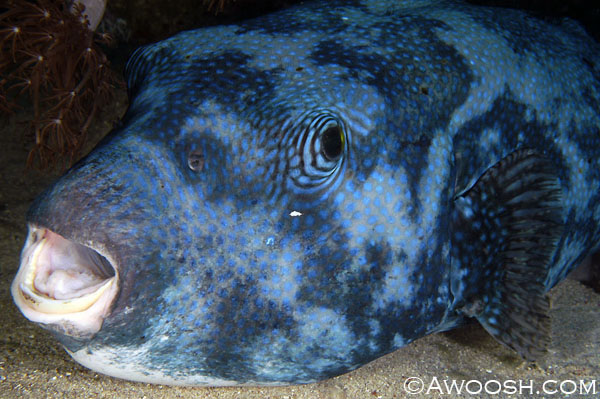
Bigass Blue Spotted Pufferfish

Soft Coral Garden
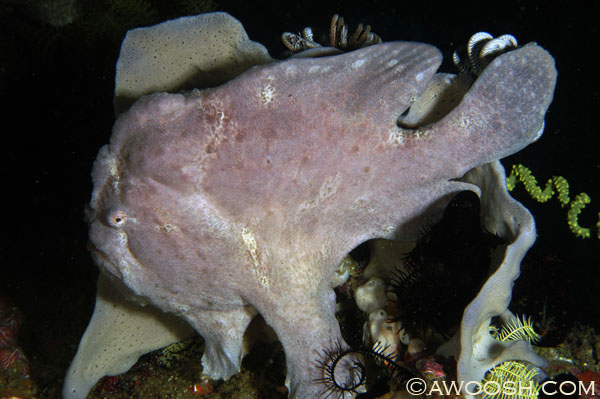
Giant Frogfish
Komodo Links: 2008/2009 Photo Gallery
___________________________________________
Lembeh
Lembeh is an island located just off of the far northeastern coast of the large island of Sulawesi. It is a destination that really appeals to muck/macro divers, as it is another of those places where there is a huge biodiversity, and healthy populations of some of the most sought after weird and wonderful Indonesian critters.
Our visit to Lembeh was our chosen land stay before heading to Ambon to board the Archipelago Adventurer II for a transitional cruise through Raja Ampat, ending in Sorong.
Getting there was not too tough – there are several non-stops weekly out of Singapore to Manado, the closest airport to Lembeh. From there it is yet another several hour van ride to get to the boat launch for the short transit over to the island.
Most of the diving in Lembeh is in the strait between the main island of Sulawesi and Lembeh island. There was some current to contend with on some dives, and deep silt which always makes setting up a macro shot challenging. Lembeh Dive Resort was great – they do it right, and deserve their popular status amongst Lembeh fanatics.
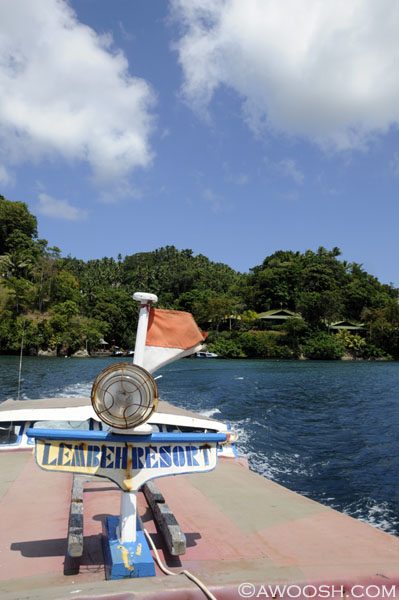
All Aboard for Lembeh Resort
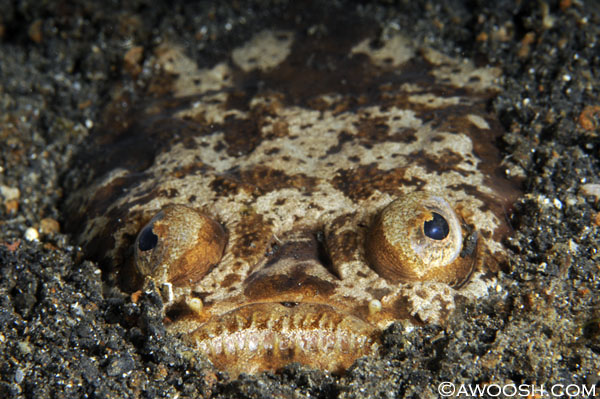
Stargazer

Emporer Shrimp on Sea Cucumber
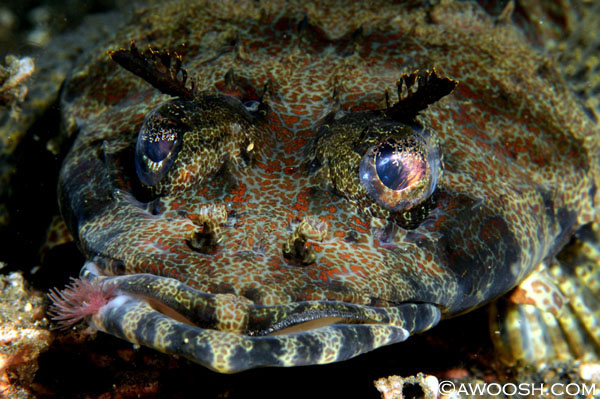
Flathead Fish
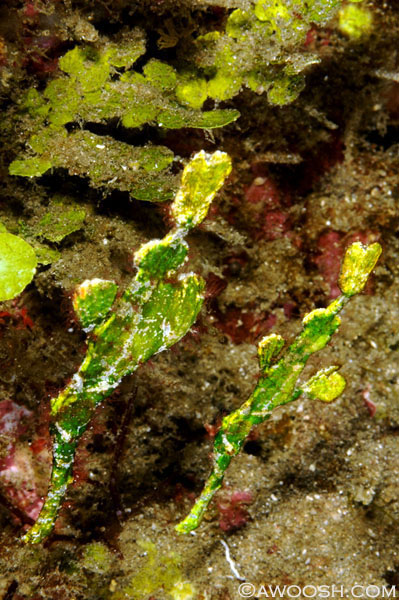
Halameda Ghost Pipefish Pair
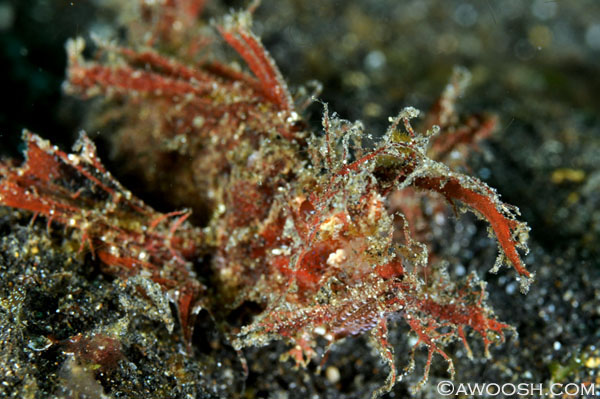
Ambon Scorpionfish

Banggai Cardinalfish
Lembeh Links: Awoosh Lembeh Pictorial Trip Report | 2010 Gallery
___________________________________________
Raja Ampat
Ah, the ‘Four Kings’ of Indonesia. This group of islands is located in the far eastern reaches of Indonesia. Made up of four major islands (the four kings) and innumerable small islets, it is, both topside and underwater, a stunningly beautiful location. And the biodiversity does not suck either ;^) Raja Ampat is another of those places where it becomes a constant conundrum – which lens to shoot? There are epic wide angle scenes (Boo Rock, Black Rock to name a couple), there are schooling fish, and there are a seemingly unlimited number of macro subjects to focus on.
Our trip was a transition cruise from Ambon to Sorong (fondly known as ‘So Wrong’ – truly, not a nice place to spend time). If I did this trip again, I would suck it up and fly into Sorong, and return to Sorong at the end. In my opinion, the best diving was around Misool and east towards Sorong. The first few days of our trip entailed a lot of travel time, and not much great diving…
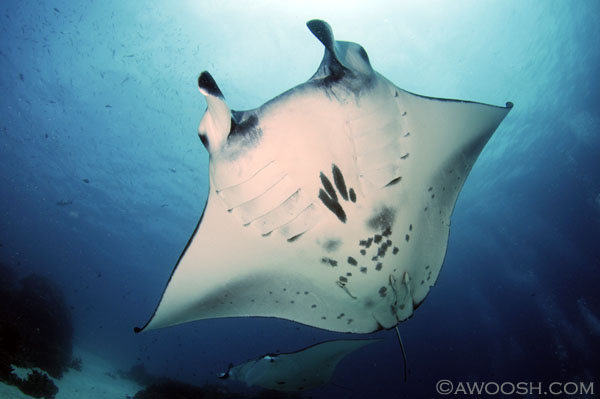
Mantas at Manta Sandy
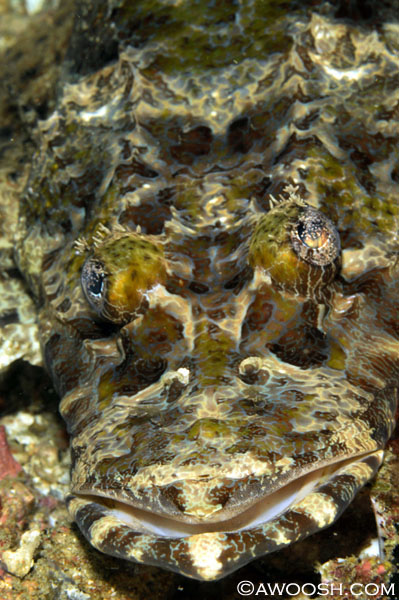
Crocodile Fish

Boo Rock
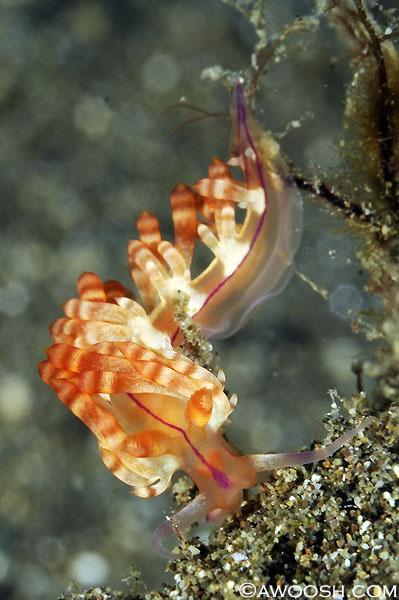
Flabellina Rubrolineolata Nudibranch
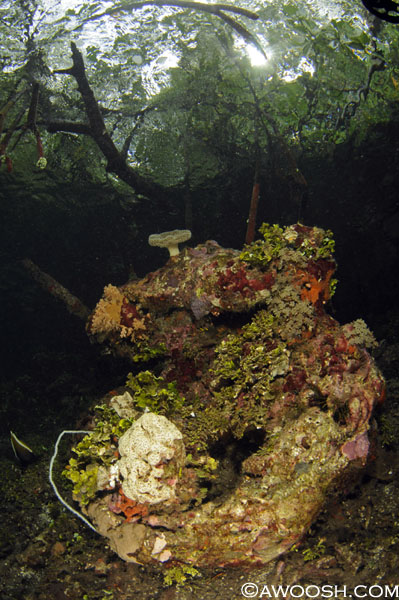
Mangrove

Beautiful Topography

Glossodoris Cinta Nudibranch
Raja Ampat Links: Awoosh Raja Ampat Pictorial Trip Report | 2010 Photo Gallery
And that’s all she wrote, folks…

